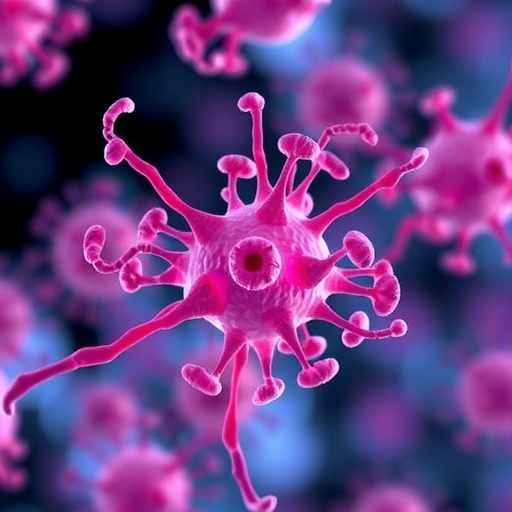Cancer-associated fibroblasts (CAFs) have long been recognized as pivotal yet perplexing components within the tumor microenvironment, influencing cancer progression and therapeutic responses in complex ways. Emerging evidence, summarized comprehensively in a recent literature review published in Clinical and Translational Discovery, reveals a paradoxical nature of CAFs that challenges conventional understanding. While these stromal cells predominantly contribute to immunosuppression and tumor advancement, certain subpopulations exhibit tumor-restraining functions, underscoring their biological heterogeneity and functional plasticity.
At the core of the paradox lies the diverse phenotypic and functional landscape of CAFs. These cells, originating from various sources including resident fibroblasts, mesenchymal stem cells, and possibly endothelial-to-mesenchymal transition, adopt distinct molecular signatures and secretomes depending on tissue context and tumor subtype. This heterogeneity dictates their dualistic influence: some subsets foster immune evasion and metastatic potential, whereas others facilitate immune surveillance and constrain tumor growth. Such dichotomy complicates therapeutic strategies aimed at targeting CAFs, as indiscriminate depletion may paradoxically promote metastasis and worsen patient prognosis.
Mechanistically, CAFs orchestrate immunotherapy resistance through multiple intricate pathways. One prominent mode involves remodeling the extracellular matrix (ECM), where activated CAFs deposit abundant collagen and fibronectin, creating dense physical barriers that impede immune cell infiltration. This stromal fibrosis not only limits access of cytotoxic T lymphocytes but also alters tissue stiffness, which can modulate signaling pathways critical for both tumor and immune cells. Moreover, CAFs actively reprogram the phenotype of tumor-infiltrating immune cells. For example, they secrete cytokines such as transforming growth factor-beta (TGF-β) and interleukin-6 (IL-6), which drive macrophages toward a pro-tumoral M2 phenotype and induce T-cell exhaustion or regulatory T-cell expansion, thereby dampening anti-tumor immunity.
.adsslot_2hl9EnpyxX{ width:728px !important; height:90px !important; }
@media (max-width:1199px) { .adsslot_2hl9EnpyxX{ width:468px !important; height:60px !important; } }
@media (max-width:767px) { .adsslot_2hl9EnpyxX{ width:320px !important; height:50px !important; } }
ADVERTISEMENT
Another layer of complexity emerges from CAF-derived extracellular vesicles, including exosomes enriched with immunosuppressive cargos. These vesicles facilitate horizontal transfer of modulatory RNAs and proteins to immune cells, further subverting immune responses and enhancing tumor survival. Consequently, tumors characterized by high CAF density are frequently refractory to PD-1/PD-L1 checkpoint inhibitors, a cornerstone of modern immunotherapy, illustrating the formidable barrier CAFs pose to effective treatment.
Intriguingly, in cancers such as pancreatic ductal adenocarcinoma and certain subtypes of breast cancer, select CAF populations, notably those expressing alpha-smooth muscle actin (αSMA), exhibit paradoxical anti-tumor activity. These CAFs have been observed to promote infiltration and activation of cytotoxic CD8+ T cells, attenuating tumor progression. Such findings illuminate the nuanced roles of CAF subsets and underscore the danger of broad-spectrum CAF elimination, which risks destroying beneficial fibroblast populations essential for restraining tumor expansion.
Complementing cellular therapies, strategies inhibiting CAF-secreted soluble factors are also under rigorous investigation. Blocking chemokines like CXCL12, which recruits immunosuppressive cells and promotes fibrosis, or antagonizing TGF-β signaling pathways has been shown to normalize the tumor microenvironment. These interventions aim to dismantle the immunosuppressive network orchestrated by CAFs, facilitating deeper penetration and activity of immune effector cells.
Nevertheless, the pursuit of CAF-directed therapies is fraught with challenges. FAP, although enriched in tumor-associated fibroblasts, is also expressed in certain normal tissues, raising concerns about potential off-target toxicities and adverse effects. Achieving therapeutic precision necessitates comprehensive mapping of CAF heterogeneity at single-cell resolution across diverse cancer types, enabling identification of context-dependent functional subtypes amenable to selective targeting.
Furthermore, the development of reliable biomarkers to stratify patients who would benefit from CAF-modulating treatments remains an urgent clinical need. Such precision oncology tools would not only optimize therapeutic outcomes but also minimize unwarranted toxicity, a critical balance in the translation of these approaches from bench to bedside.
Experts like Dr. Peng Luo and Dr. Jian Zhang emphasize the imperative of embracing the complexity and duality of CAF biology. Their insights advocate for a paradigm shift—from viewing CAFs as universal adversaries to recognizing their contextual roles within the dynamic tumor ecosystem. This nuanced understanding paves the way for designing sophisticated combination therapies that harness the protective CAF functions while neutralizing their tumor-promoting counterparts.
In summary, the emerging narrative of cancer-associated fibroblasts as both friend and foe in tumor immunotherapy highlights the intricate symbiosis between stromal cells, immune components, and cancer cells. Unraveling the molecular mechanisms underpinning this paradox will be instrumental in overcoming therapeutic resistance and advancing personalized oncology. As research progresses, integrating CAF-targeted interventions holds the promise of transforming the immunotherapeutic landscape and improving survival outcomes for patients afflicted with formidable malignancies.
Subject of Research: Not applicable
Article Title: Friend or foe: The paradoxical roles of cancer-associated fibroblasts in tumour immunotherapy.
Web References: http://dx.doi.org/10.1002/ctd2.70056
Keywords: Cancer
Tags: CAF heterogeneity and plasticitycancer-associated fibroblastsdual roles of cancer-associated fibroblastsextracellular matrix remodeling in tumorsfibroblast subpopulations in cancerimmune evasion in cancerimmunotherapy resistance mechanismsrole of fibroblasts in cancerstromal fibrosis and immune infiltrationtherapeutic strategies for targeting CAFstumor microenvironment complexitytumor-promoting and restraining fibroblasts





